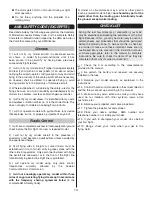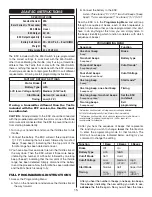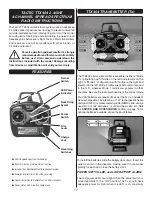
13
●
The motor gets hot! Do not touch it during or right
after operation.
●
Do not throw anything into the propeller of a
rotating motor.
AMA SAFETY CODE (EXCERPTS)
Read and abide by the following excerpts from the Academy
of Model Aeronautics Safety Code. For the complete Safety
Code refer to
Model Aviation
magazine, the AMA web site or
the Code that came with your AMA license.
General
1) I will not fl y my model aircraft in sanctioned events,
air shows, or model fl ying demonstrations until it has
been proven to be airworthy by having been previously,
successfully fl ight tested.
2) I will not fl y my model aircraft higher than approximately
400 feet [120m] within 3 miles [4.8km] of an airport without
notifying the airport operator. I will give right-of-way and avoid
fl ying in the proximity of full-scale aircraft. Where necessary,
an observer shall be utilized to supervise fl ying to avoid
having models fl y in the proximity of full-scale aircraft.
3) Where established, I will abide by the safety rules for the
fl ying site I use, and I will not willfully and deliberately fl y my
models in a careless, reckless and/or dangerous manner.
5) I will not fl y my model unless it is identifi ed with my name
and address or AMA number, on or in the model. Note: This
does not apply to models while being fl own indoors.
7) I will not operate models with pyrotechnics (any device
that explodes, burns, or propels a projectile of any kind).
Radio Control
1) I will have completed a successful radio equipment ground
check before the fi rst fl ight of a new or repaired model.
2) I will not fl y my model aircraft in the presence of
spectators until I become a qualifi ed fl ier, unless assisted by
an experienced helper.
3) At all fl ying sites a straight or curved line(s) must be
established in front of which all fl ying takes place with the
other side for spectators. Only personnel involved with fl ying
the aircraft are allowed at or in the front of the fl ight line.
Intentional fl ying behind the fl ight line is prohibited.
4) I will operate my model using only radio control
frequencies currently allowed by the Federal
Communications Commission.
5)
I will not knowingly operate my model within three
miles of any pre-existing fl ying site except in accordance
with the frequency sharing agreement listed
[in the
complete AMA Safety Code].
9) Under no circumstances may a pilot or other person
touch a powered model in fl ight;
nor should any part of the
model other than the landing gear intentionally touch
the ground, except while landing.
CHECK LIST
During the last few moments of preparation your mind
may be elsewhere anticipating the excitement of the fi rst
fl ight. Because of this, you may be more likely to overlook
certain checks and procedures that should be performed
before the model is fl own. To help avoid this, a check list
is provided to make sure these important areas are not
overlooked. Many are covered in the instruction manual,
so where appropriate, refer to the manual for complete
instructions. Be sure to check the items off as they are
completed (that’s why it’s called a
check list!
).
❏
1. Check the C.G. according to the measurements
provided in the manual.
❏
2. Be certain the battery and receiver are securely
installed in the fuse.
❏
3. Balance your model
laterally
as explained in the
instructions.
❏
4. Confi rm that all controls operate in the correct direction
and the throws are set up according to the manual.
❏
5. Make sure any servo extension cords you may have
used do not interfere with other systems (servo arms,
pushrods, etc.).
❏
6. Balance your propeller (and spare propellers).
❏
7. Tighten the propeller nut and spinner.
❏
8.
Place your name, address, AMA number and
telephone number on or inside your model.
❏
9. If you wish to photograph your model, do so before
your fi rst fl ight.
❏
10. Range check your radio when you get to the
flying field.










































